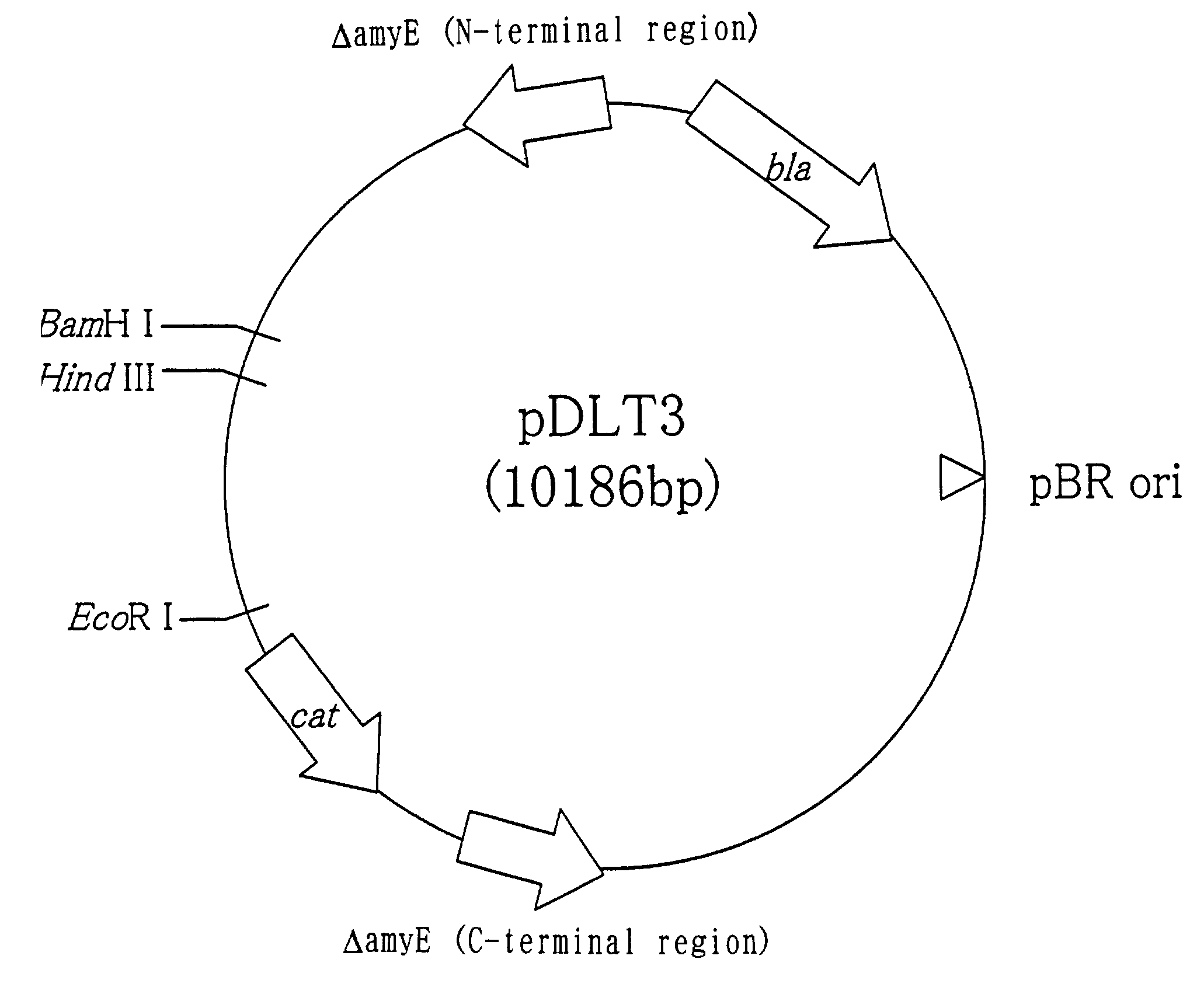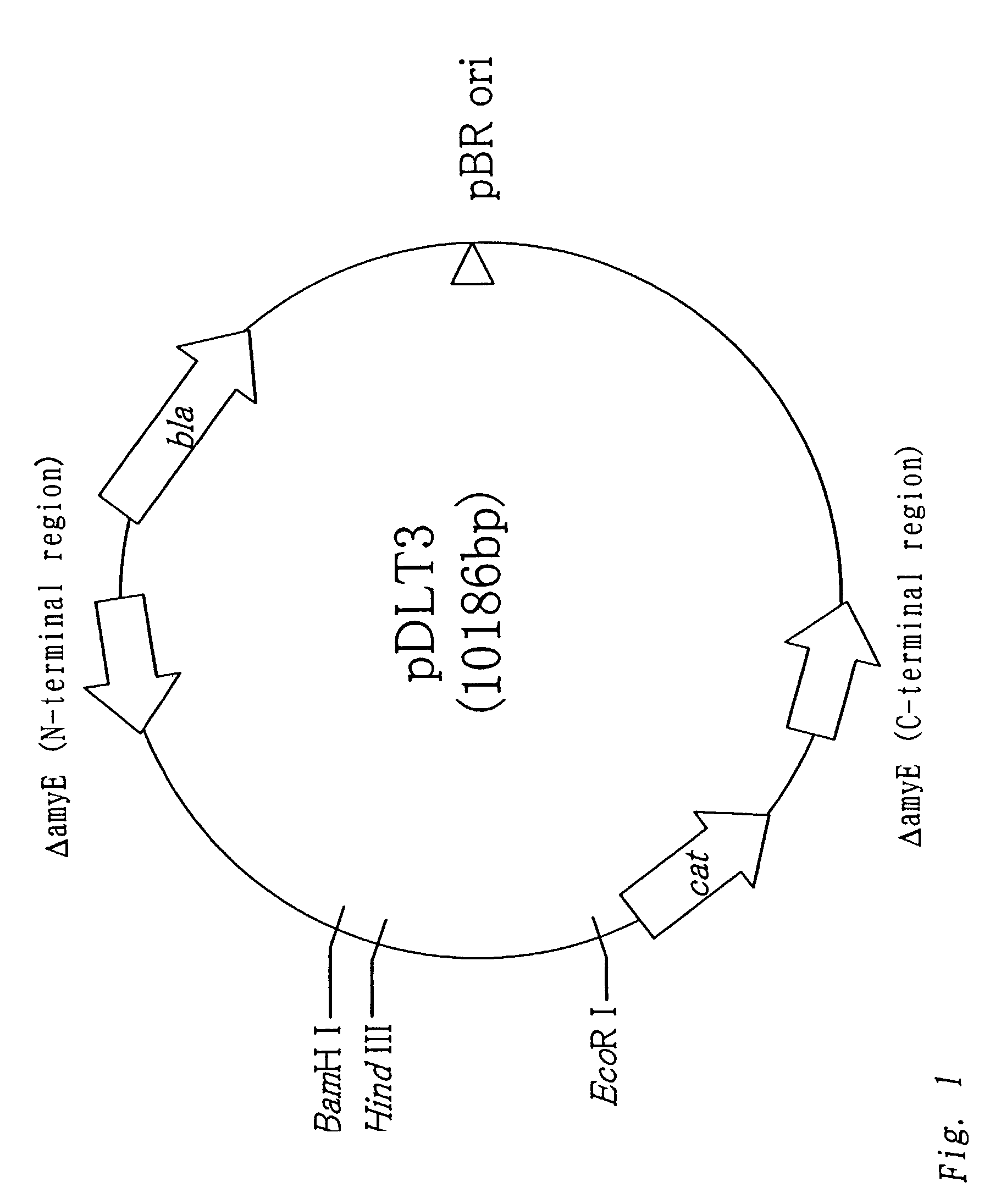Method for producing target substance
a technology of target substance and method, which is applied in the field of microbial fermentation industry, can solve the problems that all the bacterial strains have not acquired high productivity of amino acids acceptable as bacteria, and achieve the effect of reducing the number of bacterial strains
- Summary
- Abstract
- Description
- Claims
- Application Information
AI Technical Summary
Benefits of technology
Problems solved by technology
Method used
Image
Examples
example 1
Cloning of Methanol Dehydrogenase Gene
[0062]Chromosomal DNA was prepared in a conventional manner from Bacillus brevis S1 strain (NCIMB 12524, obtained from NCIMB), which is a methanol-assimilating high-temperature resistant bacterium belonging to the genus Bacillus. Then, an MDH gene was cloned by PCR method using this DNA as a template (refer to Japanese Patent Laid-open Publication No. 2000-69976).
[0063]The DNA primers used were MDH-BM-1 (SEQ ID NO: 1) and MDH-BM-2 (SEQ ID NO: 2). These were prepared by referring to the already known nucleotide sequence of the MDH gene of Bacillus methanolicus C1 strain (registered at GenBank under Accession M65004, entry name of BACMDH). PCR was performed by using LA-Taq (Takara Shuzo) and consisted of a heat treatment at 94° C. for 90 seconds, following reactions at 98° C. for 10 seconds, 55° C. for 30 seconds and 70° C. for 4 minutes repeated for 30 cycles, and further following incubation at 72° C. for 10 minutes. A DNA fragment of the desire...
example 2
Incorporation of mdh into Chromosome of L-lysine-producing Bacillus subtilis Strain
[0070]The Bacillus subtilis AJ11779 strain modified so that it could produce L-lysine is a strain described in Japanese Patent Laid-open Publication No. 58-149689. To this strain, the L-lysine producing ability was imparted by imparting resistance to the growth inhibition by AEC, which is lysine analogue compound and threonine. This strain was deposited at the independent administrative institution, National Institute of Advanced Industrial Science and Technology, International Patent Organism Depository (Address: postal code 305-5466, Chuo Dai-6, 1-1 Higashi 1-Chome, Tsukuba-shi, Ibaraki-ken, Japan) on Aug. 9, 2001 and given with an accession number of FERM P-18453. Then, the deposition was changed to an international deposition under the provisions of the Budapest Treaty on Aug. 19, 2002 and given with an accession number of FERM BP-8155.
[0071]It was planned to incorporate the mdh gene described in...
example 3
Cloning of Gene Coding for MDH Activator (Amd) Derived from Bacillus subtilis
[0074]It is known that there are factors for activating enzymatic activity of NAD-dependent type methanol dehydrogenases derived from methanol-assimilating bacteria belonging to the genus Bacillus. Japanese Patent Laid-open Publication No. 2000-69976 (OP884) discloses that one of such factors exists in Bacillus subtilis. This factor was designated as Amd (Activator of methanol dehydrogenase).
[0075]The gene coding for Amd (amd) was cloned from Bacillus subtilis in an already known manner. Specifically, the cloning was carried out as follows. The Bacillus subtilis 168 strain was cultured in LB medium, and chromosomal DNA was extracted from the obtained cells in a conventional manner (Biochem. Biophys. Acta., 72, 619–629 (1963)). This chromosomal DNA was used as a template in PCR using such oligonucleotides that the target DNA fragment should have EcoRI restriction enzyme sites on the both ends (SEQ ID NOS: 1...
PUM
 Login to View More
Login to View More Abstract
Description
Claims
Application Information
 Login to View More
Login to View More - R&D
- Intellectual Property
- Life Sciences
- Materials
- Tech Scout
- Unparalleled Data Quality
- Higher Quality Content
- 60% Fewer Hallucinations
Browse by: Latest US Patents, China's latest patents, Technical Efficacy Thesaurus, Application Domain, Technology Topic, Popular Technical Reports.
© 2025 PatSnap. All rights reserved.Legal|Privacy policy|Modern Slavery Act Transparency Statement|Sitemap|About US| Contact US: help@patsnap.com


